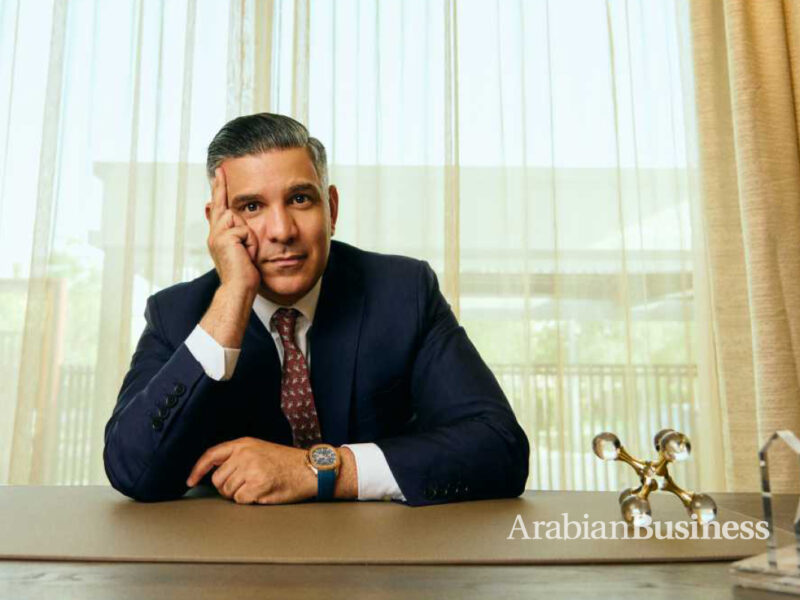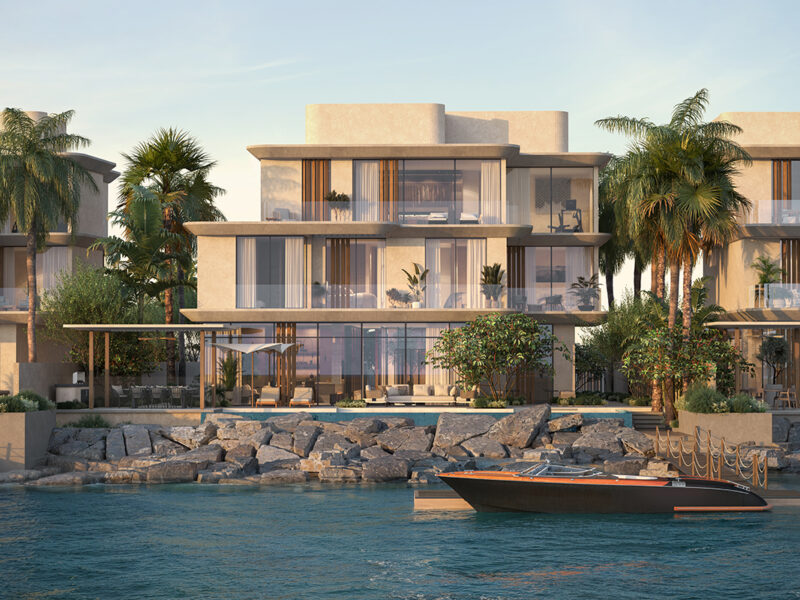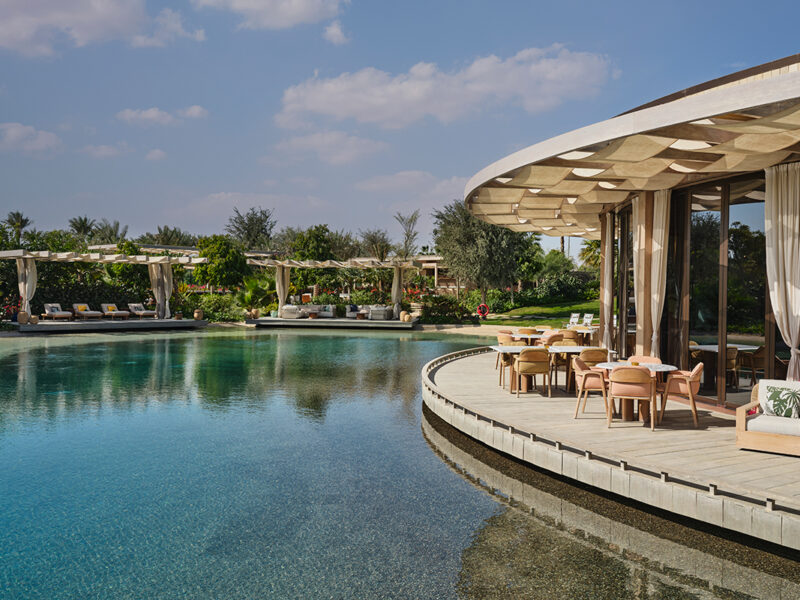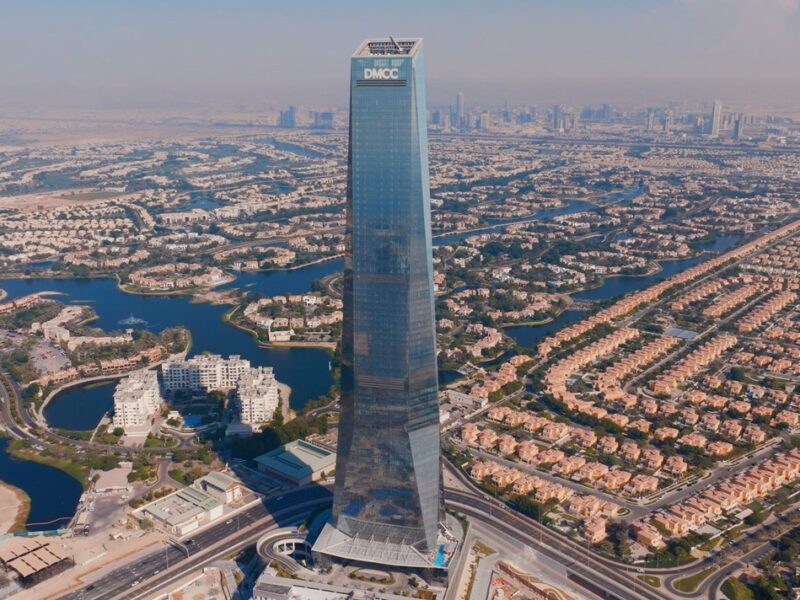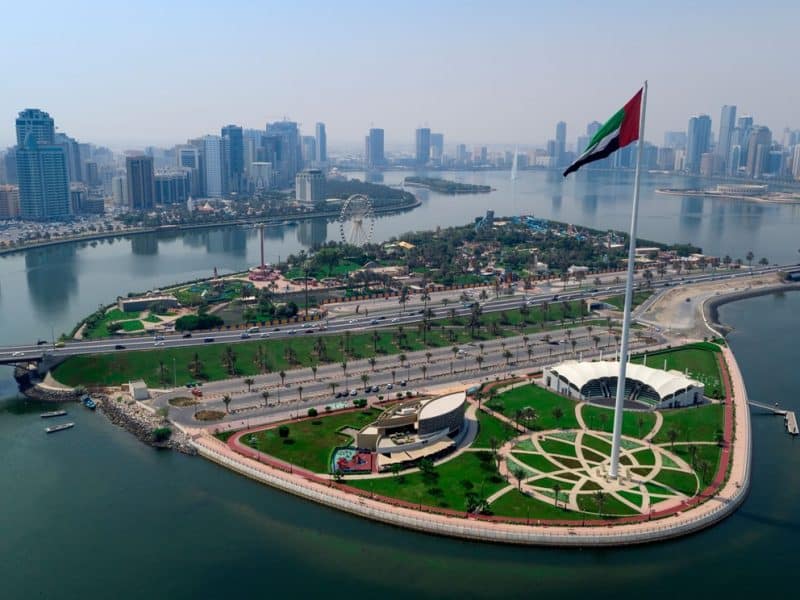On July 21st, Emaar announced that Dubai now owns yet another icon: the tallest building in the world. Depriving Taipei 101 (508m,1667ft high) of its “world’s tallest tower” title, a year and half ahead of completion and already 512 meters tall, Burj Dubai is in the centre of the spotlight.
The desire to build tall buildings is nothing new. From the time of Babel, history of all tall buildings has always been linked with human obsession of showing off the power, prosperity and wealth by reaching higher and creating bigger things. The ambitious and the powerful always tried to stretch the limit of possibility by building something higher and bigger than what had existed. With the achievement of Burj Dubai, this city will be recognised to have done another big job; showing the world that, once a desert, it can now build a tower taller than anything else. Dubai will be proving that the limitation of growth can be stretched, hopefully not only the high of its iconic skyscraper but that of its booming real estate market.
Dubai market outlook: to buy or not to buy?
Over the past few months, analysts, journalists and observers of Dubai real estate market have warned that the booming Dubai real estate market has reached its peak and is now going to go through a “market adjustment”. The handover of thousands of apartment units in Jumeirah Beach Residence had been rumoured to be the trigger to “rental price” slowdown. However, even today, if you check any daily paper, you will find that neither the rental nor sales price of any property in this market has dropped.
“Dubai or not to buy?”
Last December, a real estate market report called ‘Dubai or not to buy’ published by an Egyptian Investment Bank, EFG Hermes made a sensation. Widely circulated among investors and market watchers, this report predicted that Dubai real estate market will reach maturity in 2008 and by 2009 the rental yields will revert to par with global average. Sana Kapadia was one of the authors of this report sees the Dubai market with a slightly different approach that takes into account the changing dynamics of this market.
The Dubai market is becoming more of a mature and developed property market where branding and marketing as well as competition matters.
“We are still collecting information on the market which is a very difficult and lengthy process to determine the status. However, our initial analysis suggest that on YTD basis, rental price increases are in the range of 10-16% on average whereas up until last year it has been 30%. This is due largely to the implemented rental cap of 7% as well as the fact that the market has reached its peak and there is not much of an uplifting space to rental price. ” Although she admits that some of the areas have still seen increase in both leasehold and freehold price, in general the leasehold market seems to have reached the peak. However, she acknowledges that the slowdown or soft-landing of the booming market is occurring at a lot slower pace than they had predicted. “We had predicted that this year with the release of mega projects as International City and Jumeirah Beach Residence there would be a commencement in the slowdown of the property market, with the delivery of these projects acting as an acid test to assess the market’s future direction.
However, we have to admit that it is a bit too early to tell the effect of these projects to the entire market. Perhaps the real slowdown might start from next year once the majority of projects are handed over as expected. ” We have to note that until the end of this year, next year’s rental cap won’t be revealed. As it was implemented to artificially control the market, nobody knows how the rental cap is going to be in 2008. It may be higher, lower or none at all. There are still quite a few unpredictable variables to affect the market.
However, Sana stresses that every market has a cycle and Dubai market will slow down at some point. The word “slowdown” seems to be much hated and dreaded in this particular market, but Sana suggests to have a look at with a slightly different angle. “The fact that it will slow down means that the market is maturing, in other words. This does not necessarily mean negative, quite the contrary, it gives more sophistication and transparency to the market; allowing the market to have a sustainable prosperity.” She already sees that the customers have started to pay further attention to location, reputation of the developer and quality of the products. This means that Dubai market is becoming more of a mature and developed property market where branding and marketing as well as competition matters. Also, she stresses that the expansion of property developments into surrounding emirates throughout the UAE, such as those in RAK, Ajman and Abu Dhabi to give an even more positive synergetic effect to Dubai market as well.
Property agents’ viewpoint
If the analyst sees the market in this way, what does the real estate agents who work most closely to the investors/buyers say?
Billy Rautenbach, operations director with Better Homes, a top real estate agency in the region, sees that the demand in general has not waned. “Our business, a brokerage has not slowed down in any way, ” Rautenbach says.
However, Rautenbach recognises a definite change in the preferred property products. The market are shifting from off plan to ready to move in products.
“We see a reduction in sales of off-plan apartments, however, completed properties, especially villas are still in high demand. The developers are now facing more competitions than ever to sell products to customers with high quality expectations, however as for a broker, we have not seen any slowdown at all.”
In fact, Better Homes has seen an increase in demand for off-plan sales of commercial properties and these have been significant and estimates this trend to continue for at least the next 12 months.
“We believe that the market will stabilise or a flattening off in next 12-18 months. It will become more competitive for developers with increased supply of delivered product and still new products being launched. The agency arena will also become more competitive allowing the more professional organisations to be recognised and the less professional agents and brokers will lose market share.”
What she stresses is, like Sana from EFG Hermes, the Dubai market to have matured enough for allowing good companies (and developments) to excel further success and wipe out those failing to meet the standard. “Location, price, payment plan, completion date and contractor… investors are now checking whether all the boxes are ticked before making a decision” hence, she says that some developments remain to be particularly strong in the market.
Dubai still an attractive market in a bigger picture
When hearing those comments, a big question rises: should Dubai market slow down in the future, is there any uplifting opportunity left?
To this question, Steve Brice, regional head of research (Middle East) with Standard Chartered Bank answers with a very interesting argument by introducing the “Big Dubai story” theory.
“As is much spoken of, we too, have seen a little bit of softness in investors/buyers activities in the Dubai real estate market. Particularly, we see the digestion of Jumeirah Beach Residence which consists of as many as 6,500 units to be an issue to affect the demand/supply balance. In the last 18 months, we were all forced to make a decision to either buy or rent a residential property immediately to get hold of it. However, we do not see such an urgency in the market.”
Brice has been predicting that the Dubai property market will see a peak towards the second half of 2007 mainly because of this JBR release issue. However, he also suggests that as it usually takes a while for handing over, so the real shock might kick in a bit later.
All the stories of “slowing down” of the market may just be the sign of a maturing and stabilising market.
Indeed, Dubai real estate market has seen an unseen level of boom due to the massive over-demand of both residential and commercial properties. It may be the case that, in the near future, with the completion of quite a few projects, this over-demand will be calmed down.
“We have started to discuss the segmentation of Dubai real estate market rather than simply looking at the market through one lens.”, says Brice. Rather, he says that the market will become increasingly sophisticated and perceived high-end, middle-end and low-end products will have winners and losers respectively.
“Lower end of apartments seem to be particularly vulnerable, for example in Dubai Marina. However, we must admit that there is still a shortage of villas in Dubai. Sought out products will most likely to maintain good levels” explains Brice.
Is Dubai still worthwhile investing in? To answer this, Brice brought “time horizon” into perspective. He says that if an investor had a longer time horizon, Dubai would still an attractive market to invest in. If you are ready to buy into the “Dubai story” of growing into major global financial/business hub, Dubai real estate products are still cheaper than those in New York, Singapore, Hong Kong, Tokyo or London. Remember also that, if you are planning to rent out the property, the yield curve is still very high. All the stories of “slowing down” of the market may just be signs of a maturing and stabilising market.
Brice also stresses that we should look at the large population growth Dubai is expecting.
“People often ask what would happen after the construction has ended in Dubai? But, the crucial thing is that the construction will never end. Dubai will keep on building. Besides, things are not being built without a purpose. Construction and real estate sector is building infrastructure to support the future growth of Dubai. We have to be, though, realistic and accept that cycles do exist in any businesses, economies and real estate market does have one, too. However, as some might be worried, Dubai real estate market will not see a crash that will hit the UAE economy. At the end of a day, the mega projects are likely to succeed. We don’t build motorways into the desert for no reason.”
Brice presents an optimistic view on Dubai economy’s future. He says that the fundamental driver that also supports the real estate market growth is the ambitious goal Dubai has set through diversification of the economy and increased size of population and economy.
Major developments in the pipeline
A market that is expanding at an unseen speed and dynamics, Dubai seems yet to offer to potential investors in both commercial and residential freehold segments.
Anyone who knows about the market is well aware of the fact that the Dubai real estate market has been established by the three big developers, Emaar, Nakheel and Dubai Holdings (Dubai Properties & Sama Dubai). Majority of the mega projects have been launched by the three and the market standard has been created by their continuous effort to meet the demand of the clients. Other big names such as DAMAC, Omniyat and Deyaar have joined the competition to make the market even more of an attractive one. Some might criticise the sustainability of the market boom, looking at some of these big names’ current success and future development projects make it difficult not to portray an exiting and bright future of this market.
Downtown Burj Dubai
Emaar properties recorded net profit of US$892m for first half of 2007 and has a land bank of 480 million sq m with a collective presence in 30 global markets. The success of Emaar in Dubai provides impetus to Emaar’s expansion internationally. Emaar has a strong product portfolio in Dubai including Downtown Burj Dubai, a US$20bn master-planned project; Dubai Marina, the largest of its kind waterfront project in the region; Arabian Ranches, a premier desert-themed neighbourhood; and Emirates Living, a collection of master-planned communities.
Downtown Burj Dubai has at its centre the world’s tallest building, Burj Dubai. The mega project spreads over 500 acres and will be a mixed-use community combining commercial, residential, leisure, shopping and hospitality projects, set amidst open green spaces and dotted with lakes and other water features. Downtown Burj Dubai will also feature The Dubai Mall, one of the world’s largest shopping and entertainment destinations, and is on schedule for completion in 2008.
Other components within Downtown Burj Dubai include The Old Town, The Old Town Island, Burj Dubai Square, Burj Views, Burj Dubai Boulevard, The Residences, South Ridge, 29 Burj Dubai Blvd, The Loft and Loft Towers, 8 Boulevard Walk, and Burj Dubai Lake Hotel and Serviced Apartments.
To be completed in phases, the 500-acre development will have 30,000 homes and nine world-class hotels including the Armani Hotel & Residence in Burj Dubai. These development projects have gained overwhelming investor response.
“Downtown Burj Dubai creates a new vibrant downtown for the city, and as a city within the city, it features all components of modern living. Apart from world-class homes, offices, shopping options and entertainment outlets, Downtown Burj Dubai is located in the heart of the city and offers easy access to the bustling nerve centres of Dubai,” says Mr Ahmad Al Matrooshi, UAE managing director, Emaar Properties.
Emaar has now expanded into six other high-growth sectors such as education, healthcare, shopping malls, industry, finance and hospitality & leisure to evolve as an integrated lifestyle provider, making the company more attractive for investors.
Recently, Emaar partnered with Dubai Department of Health and Medical Services (DoHMS) to open specialised medical facilities in Dubai including a modern Diabetes Centre. Emaar has also acquired Singapore-based leading education provider, Raffles Campus, to extend expertise to its educational institutions.
Business Bay – next door rival to Burj Dubai
Right next door to Downtown Burj Dubai, another multibillion dollar project is busy under construction. Business Bay – led by Dubai Holding’s real estate arm Dubai Properties, this project will be built on a 64 million sq ft area along a new extension of the famed Dubai Creek.
The developer intends to position this project to be a leading business capital to offer facilities similar to that provided by the likes of Manhattan of New York or Ginza of Tokyo. Dubai Properties itself have already launched both commercial and residential products in this area (Executive Towers – residential, Vision Tower – commercial) and some of the projects were successfully sold out in hours time. Upon completion, as many as 230 commercial and residential towers will be soaring in this area.
As Business Bay is located along with Sheikh Zayed Road with its proximity to Dubai International Financial Centre, this project is gaining rapid interests from both individual investors and commercial entities desperately looking for office spaces.
Regional mega developers such as Omniyat, Deyaar and Damac have launched several towers in Business Bay and most of them have reported to been sold out within short period of time. Some of the commercial towers to be completed in the near future are already in the secondary market yielding a good premium. There are yet quite a few towers to be launched in the near future from various developers. However, the launch price has been soaring up quite rapidly reflecting the rapid interests from the buyers.
The Palms – Nakheel’s floating dreams on water
A little away from the heating competition among all the skyscrapers to be built in the heart of Dubai, Nakheel is busy building its vision on the waterside. Nakheel is one of the world’s largest privately-held real estate developers, known for the Palms developments. Nakheel now has 16 major projects under development in Dubai across a range of sectors – residential, commercial, retail and leisure. Their portfolio spreads across more than two billion sq ft of land and is projected to be worth more than US$30bn. The first phase of the Palms development, The Palm Jumeirah was launched in 2001 and at the end of last year the first residents moved in. Nakheel has discovered the popularity of luxury villa products such as Signature and Garden Villas through this project and launched a second Palm, the Palm Jebel Ali in 2003.
This project is a landmark commercial, residential and tourism development for Dubai, located outside of the existing city close to Dubai’s prime international commerce and industry hubs: the Jebel Ali Port and the Jebel Ali Free Zone.
“The project will provide groundbreaking developments, whether they are residential, commercial or for tourist use. As well as adding hundreds of leisure boating berths to Dubai in some of the most exciting marina developments in the region, development of the Palm Jebel Ali will add over 85km to Dubai’s beaches,” said Marwan Al Qamzi, managing director of the Palm Jebel Ali.
Emaar has also acquired Singapore-based leading education provider, Raffles Campus, to extend expertise to its educational institutions.
The island has a surface area of 10 million sq m, and features a 20 km breakwater comprised of 10 million tonnes of rock. Along with the Waterfront project, the Palm Jebel Ali will transform an area of empty desert and sea into a bustling international community, with an estimated population of 1.7 million people by 2020. The Palm Jebel Ali alone will host an estimated 250,000 people when completed, with an infrastructure capacity for 300,000 residents.
One of the key attractions of this project would be its proximity to Jebel Ali Port and Jebel Ali Free Zone but the project seems to be more dynamic than we would expect. The masterplan has evolved to integrate with the Waterfront project, Jebel Ali Airport, and the Arabian Canal which have all launched following the announcement of the Palm Jebel Ali.
Reclamation work has already been complete as well as the construction of the artificial reef surrounding the development. Currently work on the bridges connecting the Palm to the shore is underway.
The Palm Jebel Ali is actually two discrete and unconnected islands, each with their own infrastructure and connection to the mainland. The first consists of a ‘trunk’ leading up from the shore, a ‘spine’, and sixteen ‘fronds’ which span off the spine. Surrounding this palm shape, the second is a crescent form of five segments in a semicircle linked by bridges. Splitting the channel between the crescent and the palm is an inspirational poem in Arabic ‘written’ with pontoons and visible from the air and lit at night-time by an innovative dynamic lighting system.
Like the Palm Jumeirah, developments on the Palm Jebel Ali range from luxury villa residences along the fronds including the popular Signature and Garden Villas first seen on the Palm Jumeirah. Some brand-new villas are going to be launched, designed specially created for this projects, as well as apartments and townhouses on the spine, trunk and crescents – to landmark hotels, tourism destinations and marinas. A unique feature of the Palm Jebel Ali is the waterhomes, raised on platforms above the waters of the Gulf, with their own optional private leisure boat berths and private community beaches.
“The Palm Jebel Ali is set to become a major tourism destination in itself, with its unique design ensuring it remains both a breathtaking and iconic sight. But it will also house a complete range of tourist attractions, taking full advantage of the intrinsic value of its beaches, location and marine life, which will ensure that it quickly becomes a recognised global tourism destination across the sector.,” explains Al Qamzi of his company’s ambition to bring this project up to iconic stage.
Interestingly, Nakheel has been launching groundbreaking projects such as the World, the Palms and Jumeirah Islands, all linking to the concept of “waterfront”. It is quite fascinating to hear how Nakheel has established this creative portfolio linking to the sea while there is so much land available in the desert.
Manal Shaheen, director of sales, marketing and customer service at Nakheel, explains that this comes from the company’s roots in tourism. “It was in the late 1990s and the Dubai government was very keen to promote tourism, but we were running out of one of our major assets – beachfront. Dubai only has 70km of beachfront and this had nearly all been used up. There was plenty of land in the desert, but when it comes to tourism, as well as luxury residences, you can’t beat waterfront property. Our waterfront projects were an ingenious solution to this problem. Therefore the design of a development like The Palm Jumeirah has two key distinct advantages: the Palm was both an iconic symbol of Dubai, while the fronds of the Palm were perfect for maximising beachfront. The amount of coastline created by the Palm Jumeirah is 78km, more than doubling Dubai’s coastline. Nakheel is doing something much more than just developing property – we are changing the very shape of the city, creating 1000km of coastline.”
Perhaps this spirit of innovation and boldness is something that has brought not only Nakheel but the entire Dubai real estate market to grow up to current level. Trying to build something spectacular, something bigger and bolder. This is the spirit of Dubai market and it will most probably the reason why it keeps on fascinating so many investors from around the world.
Into the future
Having looked at many of the upcoming and existing mega projects, it is hard not to believe that the market is going to have a bright future. Other than the projects highlighted here, many other projects are coming up, such as the Lagoons (Sama Dubai), Dubailand, Falcon City (in Dubailand) and the Lost City (Nakheel).
Although many say that the booming market will see a slightly different scenario compared to the last few years, those who are envisioning the future of Dubai through mega projects seem to hold bullish view.
Chris O’Donnell, Nakheel CEO, comments, “Within a four-hour flying radius of Dubai there are about 1.7 billion people. Given that Dubai has positioned itself as the commercial hub, it has a ‘first mover’ advantage over its neighbours and with that being the case, it is one of the most attractive cities in the Middle East for people to live and work.
“The Dubai market has proven to be very resilient thus far. I think that when you look at where Dubai fits into the overall region, I see no reason why the population growth and the employment growth that has been achieved here to date can’t continue to be achieved. So, if you continue to have seven percent population growth, which has been the average over the last 10 years, then by 2020, you’ll end up with a population of more than three million people. If that happens, then we could very well be in an undersupply position of homes even with all the projects that are currently identified.”
Nakheel is doing something much more than just developing property — we are changing the very shape of the city, creating 1000km of coastline.
Although O’Donnell admits that every real estate market moves in cycles and a lot coming onto the market in the next two years (half of which Nakheel will be supplying) he does not see any significant slowdown.
“For example, when we launched Jumeirah Park in September 2006, queues formed more than 12 hours before launch, and we sold 1000 properties within 24 hours. Now that we have commenced handover of residences on the Palm Jumeirah, we are also seeing the square foot selling rate increasing on a weekly basis and that is happening because people can now drive over the bridge to the Palm and see with their own eyes that the quality of the product and the views are phenomenal. Further out on the villas, people are experiencing something that other people in Dubai haven’t had the opportunity to experience: their own private beach, a modern home, well-located and well-serviced.”
The Nakheel CEO too, admits that the Dubai market is entering its maturity state, but with still a good level of appetite in Dubai to purchase property.
“Our recent launch of Jumeirah Heights proved that with the developers’ increasing ability to offer more attractive financing options and incentives, the development will help more people make the leap from renting to owning their own property.
“In our case, the combination of a specific target market, a range of finance options and the product offer itself, undoubtedly led to the hugely successful sales launch,” he adds.
Dubai market story continues
“If you bet against this government, you will lose a lot of money,” a comment of Steve Brice from Standard Chartered well describes where investors stand in this market.
“Indeed, if we see the big picture Dubai portrays, we will understand that we should be looking at long-term growth perspective rather than the recent track record or what would happen in the next few months or years,” he claims.
Take the examples of Dubai International Financial Centre, Media City, Internet City, Jebel Ali Free Zone, Dubai has been successfully built five-star infrastructure to accommodate various businesses. Dubai is now planning to launch even more ambitious plans in tourism, healthcare and many other industrial segments.
The Bawadi project aims to build massive scale of hotel and leisure facilities equivalent of Las Vegas and Dubailand looks to bring in Universal Studios and many other attraction as well as building residential developments are some good examples to promise a bright future of Dubai. Some say that the tourism industry could be even bigger than the financial sector in the future Dubai.
In any case, it would be worthwhile to keep in our mind that we tend to be short-sighted but to fully appreciate the potential of Dubai real estate market, we need to look at the bigger picture. Do not take your eyes off this magnificent market, for it will carry on becoming even sexier, bolder and innovative into the future.

